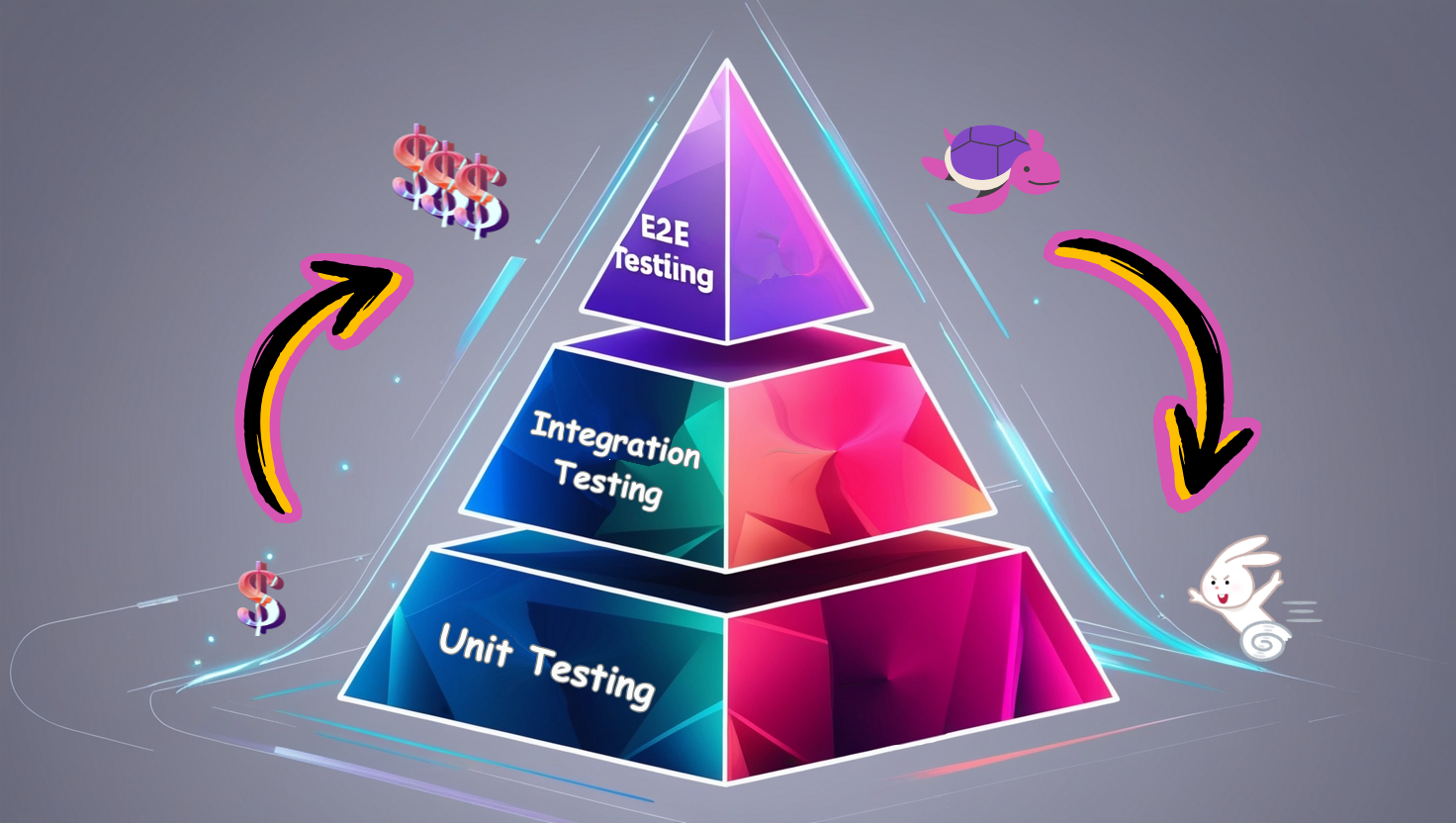Unit, Integration, and E2E Testing in One Example Using Jest
 Mohamed Mayallo
Mohamed Mayallo
Introduction
Many developers face challenges when it comes to testing their code. Without proper tests, bugs can slip through, leading to frustrated users and costly fixes.
This article will show you how to effectively apply Unit, Integration, and End-to-End testing using Jest, Supertest, and Puppeteer on a very simple example built using Node.js and MongoDB.
By the end of this article, I hope you will have a clear understanding of how to apply these types of tests in your own projects.
🧑💻 Please find the full example here in this repo.
Introducing our Dependencies
Before installing our dependencies, let me introduce our example first. It is a very simple example in which a user can open the registration page, set their registration details, click the registration button, and have their information stored in the database.
In this example, we will use the following packages:
npm install --save jest express mongoose validator
npm install --save-dev jest puppeteer jest-puppeteer mongodb-memory-server supertest npm-run-all
Most of these dependencies are straightforward, but here are clarifications for a couple of them:
puppeteer: Allows you to control a headless browser (Chrome) for automated testing and web scraping.Jest-Puppeteer: It is preset for Jest that integrates Puppeteer, simplifying the setup for running end-to-end tests in a browser environment. You can use it as a preset in thejest.config.jsfile and you can customize the Puppeteer behavior through a file calledjest-puppeteer.config.js.mongodb-memory-server: It is a utility that spins up an in-memory MongoDB instance for fast and isolated testing of database interactions.npm-run-all: A CLI tool to run multiple npm scripts in parallel or sequentially.
Unit Testing
Definition: Unit testing focuses on testing individual components or functions in isolation. The goal is to verify that each unit of code performs as expected.
Speed: Unit tests are typically very fast because they test small pieces of code without relying on external systems or databases.
Example: In our user registration example, a unit test might check the function that validates an email address. For instance, it would verify that the function correctly identifies
user@example.comas valid while rejectinguser@.comoruser.com.
Nice, let’s translate this into code.
Setting Up the Unit Testing Environment
To run your unit tests without unpredictable behaviors, you should reset the mock functions before every test. You can achieve this using the beforeEach hook:
// setup.unit.js
beforeEach(() => {
jest.resetAllMocks();
jest.restoreAllMocks();
});
Testing Email Validation
In this case, we want to test the validateInput function:
// register.controller.js
const validator = require('validator');
const registerController = async (input) => {
validateInput(input);
...
};
const validateInput = (input) => {
const { name, email, password } = input;
const isValidName = !!name && validator.isLength(name, { max: 10, min: 1 });
if (!isValidName) throw new Error('Invalid name');
...
};
It is a very simple function that validates if the provided input contains a valid email. Here is its unit test:
// __tests__/unit/register.test.js
const { registerController } = require('../controllers/register.controller');
describe('RegisterController', () => {
describe('validateInput', () => {
it('should throw error if email is not an email', async () => {
const input = { name: 'test', email: 'test', password: '12345678' };
await expect(async () => await registerController(input)).rejects.toThrow('Invalid email');
});
});
});
await expect(async () => {}).rejects: Based on the Jest documentation, this is the way to expect the reason for a rejected promise.
Testing for Duplicated Emails
Let’s test another function that checks if there is a duplicated email in the database. Actually, this one is interesting because we have to deal with the database, and at the same time, unit testing should not deal with external systems. So what should we do then? Well, we should use Mocks.
First, have a look at the emailShouldNotBeDuplicated function we need to test:
// register.controller.js
const { User } = require('../models/user');
const registerController = async (input) => {
...
await emailShouldNotBeDuplicated(input.email);
...
};
const emailShouldNotBeDuplicated = async (email) => {
const anotherUser = await User.findOne({ email });
if (anotherUser) throw new Error('Duplicated email');
};
As you see, this function sends a request to the database to check if there is another user having the same email. Here’s how we can mock the database call:
// __tests__/unit/register.test.js
const { registerController } = require('../controllers/register.controller');
const { User } = require('../models/user');
describe('RegisterController', () => {
describe('emailShouldNotBeDuplicated', () => {
it('should throw error email is duplicated', async () => {
const anotherUser = {},
input = { name: 'test', email: 'test@test.com', password: '12345678' };
const spy = jest.spyOn(User, 'findOne').mockResolvedValue(anotherUser);
await expect(async () => await registerController(input)).rejects.toThrow('Duplicated email');
expect(spy).toHaveBeenNthCalledWith(1, { email: 'test@test.com' });
});
});
});
We mocked (spied) the database findOne method using jest.spyOn(object, methodName) which creates a mock function and tracks its calls. As a result, we can track the number of calls and the passed parameters of the spied findOne method using the toHaveBeenNthCalledWith.
Integration Testing
Definition: Integration testing evaluates how multiple components work together. It checks the interactions between different functions, modules, or services.
Speed: Integration tests are slower than unit tests because they involve multiple components and may require database access or network calls.
Example: For the user registration process, an integration test could verify that when sending the registration request, the user data is correctly validated and stored in the database. This test would ensure that all components—like the input validation, API endpoint, and database interaction—work together as intended.
Setting Up the Integration Testing Environment
Before writing our integration test, we have to configure our environment:
// setup.integration.js
const mongoose = require('mongoose');
const { MongoMemoryServer } = require('mongodb-memory-server');
const { server } = require('../../server');
let testingApp;
let inMemoryServer;
beforeAll(async () => {
jest.setTimeout(50000);
inMemoryServer = await MongoMemoryServer.create({
instance: {
dbName: 'my-db-test'
}
});
await mongoose.connect(inMemoryServer.getUri());
const app = server();
testingApp = app.listen(3004);
});
afterAll(async () => {
await inMemoryServer?.stop();
testingApp?.close();
});
beforeEach(async () => {
await mongoose.connection.collections['users'].drop();
});
module.exports = () => testingApp;
As you see, we export the
testingAppbecause we will need it in the integration tests. And we export it as a function because it is being exported before it is fully initialized, sincebeforeAllis asynchronous, themodule.exportsstatement runs beforetestingAppis assigned a value, resulting in it beingundefinedwhen we try to use it in our test files.By using Jest hooks, we were able to do the following:
beforeAll: Starts the Express server and connects to the in-memory MongoDB database.afterAll: Closes the Express server and stops the running in-memory MongoDB database.beforeEach: Cleans up the database by dropping theuserscollection before each test case.
Now, we are ready to run our integration test.
Testing the Registration API Request
Let’s test the entire server-side registration process—from sending the registration request to storing user details in the database and redirecting to the success page:
// server.js
const { registerController } = require('./controllers/register.controller');
...
app.get('/success', (_, res) => {
res.send('User is registered successfully');
});
app.post('/register', async (req, res) => {
try {
await registerController(req.body);
} catch (error) {
res.redirect(`/error?msg=${error.message}`);
return;
}
res.redirect('/success');
});
...
// register.controller.js
const registerController = async (input) => {
validateInput(input);
await emailShouldNotBeDuplicated(input.email);
const user = await createUser(input);
return user;
};
...
As you see, the registerController function integrates multiple components (functions), validateInput, emailShouldNotBeDuplicated, and createUser functions.
So, let’s write our integration test:
// __tests__/integration/register.test.js
const request = require('supertest');
const { User } = require('../models/user');
describe('RegisterController', () => {
it('should create user and redirect to the success page', async () => {
const input = { name: 'test', email: 'test@test.com', password: '12345678' };
const res = await request(testingApp).post('/register').send(input);
const users = await User.find();
expect(res.status).toEqual(302);
expect(res.headers.location).toEqual('/success');
expect(users.length).toBe(1);
expect(users[0]._id).toBeDefined();
expect(users[0].email).toEqual(input.email);
});
});
As you see, in this test case, we use the
supertestpackage to send a registration request to our API. This simulates real user behavior during the registration process.In this case, we didn’t mock the database calls, because we need to test the real behavior.
End-to-End (E2E) Testing
Definition: E2E testing simulates real user scenarios to validate the entire application flow from start to finish. It tests the application as a whole, including the user interface and backend services.
Speed: E2E tests are the slowest among the three types because they involve navigating through the application interface and interacting with various components, often requiring multiple network requests.
Example: In the context of user registration, an E2E test would simulate a user opening the registration page, filling out their details (like name, email, and password), clicking the “Register” button, and then checking if they are redirected to a success page. This test verifies that every part of the registration process works seamlessly together from the user’s perspective.
Let’s jump into our example.
Setting Up the E2E Testing Environment
Actually, in our example, the environment configuration for end-to-end testing is similar to that of integration testing.
Testing Registration Process from Start to End
In this case, we need to exactly simulate real user registration behavior, from opening the registration page, filling in their details (name, email, password), clicking the “Register” button, and finally being redirected to a success page. Have a look at the code:
// register.html
...
<form
id="register-form"
method="post"
action="/register"
style="display: flex; flex-direction: column; gap: 10px; width: 30%; margin: 0 auto"
>
Name: <input class="name-input" name="name" type="text" />
Email: <input class="email-input" name="email" type="email" />
Password: <input class="password-input" name="password" type="password" />
<button class="submit-button" type="submit">Register</button>
</form>
...
// server.js
const { registerController } = require('./controllers/register.controller');
...
app.get('/success', (_, res) => {
res.send('User is registered successfully');
});
app.post('/register', async (req, res) => {
try {
await registerController(req.body);
} catch (error) {
res.redirect(`/error?msg=${error.message}`);
return;
}
res.redirect('/success');
});
...
// register.controller.js
...
const registerController = async (input) => {
validateInput(input);
await emailShouldNotBeDuplicated(input.email);
const user = await createUser(input);
return user;
};
...
Here’s our end-to-end test:
// __tests__/e2e/register.test.js
const { User } = require('../models/user');
describe('RegisterController', () => {
it('should create user and redirect to the success page', async () => {
const input = { name: 'test', email: 'test@test.com', password: '12345678' };
await page.goto('http://localhost:3004/');
await page.type('#register-form .name-input', input.name);
await page.type('#register-form .email-input', input.email);
await page.type('#register-form .password-input', input.password);
await page.click('#register-form .submit-button');
await page.waitForNavigation();
const currentUrl = page.url();
const users = await User.find();
expect(currentUrl).toBe('http://localhost:3004/success');
expect(users.length).toBe(1);
expect(users[0]._id).toBeDefined();
expect(users[0].email).toEqual(input.email);
});
});
Let’s break down this code:
There are a lot of tools you can use to implement your end-to-end testing, here we are using Jest along with Puppeteer to implement our end-to-end testing.
You might be wondering what is
pagevariable? Like Jestexpect, it is a global variable provided by Puppeteer, representing a single tab in a browser where we can perform actions like navigating and interacting with elements.We are using Puppeteer to simulate the user behavior by opening that page using
gotofunction, filling in the inputs usingtypefunction, clicking the registration button usingclickfunction.
Running All Tests Together with Different Configurations

Photo by Nathan Dumlao on Unsplash
At this point, you might be wondering how to run all test types simultaneously when each has its own configuration. For example:
In unit testing, you need to reset all mocks before every test case, while in integration testing, this is not necessary.
In integration testing, you must set up your database connection before running your tests, but in unit testing, this is not required.
So, how can we run all the test types at the same time while ensuring that each respects its corresponding configuration?
To tackle this problem, follow these steps:
1. Let’s create three different configuration files, jest.unit.config.js:
module.exports = {
rootDir: '../..',
testMatch: ['<rootDir>/__tests__/unit/**/*.js'],
setupFilesAfterEnv: ['<rootDir>/__tests__/config/setup.unit.js']
};
jest.integration.config.js:
module.exports = {
rootDir: '../..',
testMatch: ['<rootDir>/__tests__/integration/**/*.js'],
setupFilesAfterEnv: ['<rootDir>/__tests__/config/setup.integration.js']
};
jest.e2e.config.js:
module.exports = {
rootDir: '../..',
preset: 'jest-puppeteer',
testMatch: ['<rootDir>/__tests__/e2e/**/*.js'],
setupFilesAfterEnv: ['<rootDir>/__tests__/config/setup.e2e.js']
};
2. Next, update your npm scripts in the package.json file as follows:
"test:unit": "jest --config=__tests__/config/jest.unit.config.js --detectOpenHandles --runInBand --forceExit",
"test:integration": "jest --config=__tests__/config/jest.integration.config.js --detectOpenHandles --runInBand --forceExit",
"test:e2e": "jest --config=__tests__/config/jest.e2e.config.js --detectOpenHandles --runInBand --forceExit",
"test": "npm-run-all --parallel test:unit test:integration test:e2e",
--config: Specifies the path to the Jest configuration file.
npm-run-all --parallel: Allows running all tests in parallel.
3. Then, create three setup files named setup.unit.js, setup.integration.js, and setup.e2e.js, containing the necessary setup code used in the previous sections. 4. Finally, run all tests by executing this command npm run test. This command will execute all unit, integration, and end-to-end tests in parallel according to their respective configurations.
Conclusion
In this article, we explored unit, integration, and end-to-end (E2E) testing, emphasizing their importance for building reliable applications. We demonstrated how to implement these testing methods using Jest, Supertest, and Puppeteer in a simple user registration example with Node.js and MongoDB.
In fact, a solid testing strategy not only improves code quality but also boosts developer confidence and enhances user satisfaction.
I hope this article has provided you with useful insights that you can apply to your own projects. Happy testing!
Think about it
If you found this article useful, check out these articles as well:
Thanks a lot for staying with me up till this point. I hope you enjoy reading this article.
Subscribe to my newsletter
Read articles from Mohamed Mayallo directly inside your inbox. Subscribe to the newsletter, and don't miss out.
Written by

Mohamed Mayallo
Mohamed Mayallo
I'm a Software Engineer Passionate about Clean Code, Design Patterns, and System Design. Learning something new every day. Feel free to say Hi on LinkedIn at https://www.linkedin.com/in/mayallo